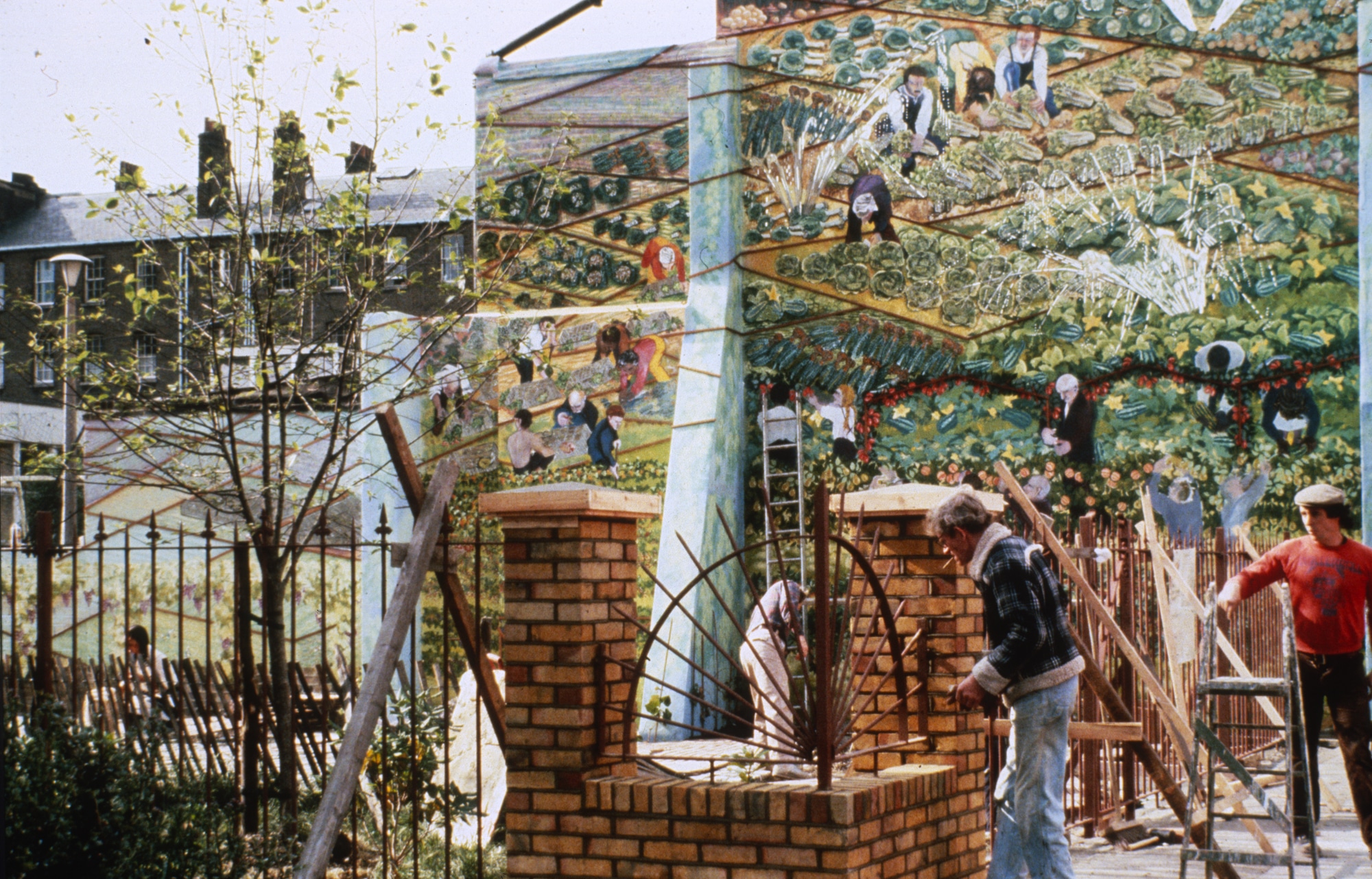Martin founded Freeform Arts with Jim Ives and Barbara Wheeler-Early
Martin was born 26 March 1943 in South Harrow, his father in the air force, his mother a nurse, the family centred in Hackney where his father grew up and his mother was trained as a nurse. His father’s pedigree was staunch labour and his grandfather became the first Labour MP for Hackney. His mother was Irish middle-class, her father a stonemason. Martin was the second child of eight and surrounded by seven sisters. From their first house in Hackney they later moved to a council house estate Debden near Loughton. “My youth was Epping Forest,” but through his parents conversation always about London and its good places – “Walthamstow and Hackney were mecca – Our culture was London” he says. And being three parts Irish, there were holidays spent with his grandparents in Ahascragh in Galway.
He went to Catholic schools, Primary in Woodford Wells then by bus to Kimberly Road School in Chingford. Because of his dyslexia, Martin was thought to be slow and it ruined his confidence. Failing the eleven-plus he went to a ten guinea-a-term Catholic Christian Brothers’ school in Chingford where drawing, play and football were his chief pursuits. He left with ‘O’ levels in art and geography and became a drawing office junior at Lotus Cars in Chestnut. “An exciting place where Colin Chapman inspired us all by presenting his drawings for his new Formula 1 car and instructing the team to build it in 3 months to compete in the new season.” The car won Lotus its first F1 race at Monaco in June that year. This experience showed the way, the power of drawing, teamwork and total commitment. Realising that he could not progress without qualifications he left and went to technical college to get ‘O’ and ‘A’ levels, and followed up by getting into Walthamstow Art School, “Where I had a fantastic time. The atmosphere to learning, camaraderie, the competition – the brilliance of art school training at that time – I learned to draw so fast!” At the end of the year he won the drawing prize. “I had defeated my dyslexia.” From there he went to the Royal College of Art to study painting, a more isolating experience than before, now with a greater sense of purpose, “Asking: what does the future hold for you as an artist, how are you going to use this talent?”
He got a job teaching at a secondary modern school in the East End – in a rough tough area, and without teaching experience began to engage the pupils by painting a mural of themselves on the art room walls. “I was having conversations with the kids to get them engaged – how to be a part of real live painting. You get them interested because of them – not because of you – you see what they’ve got to offer. Then a class of new immigrant Pakistani children arrived, they were wonderful. Their graphic ability was so superior and their use of colour, it was part of their culture. My teaching was beginning to influence me on how to share your experiences with others – how to grow something together of a cultural nature; and that is what teaching is.
In a way I was discovering socialism, in the sense that it’s your relationship to your neighbours, to your country, to your friends – the importance that they have on your life – this notion of the artist in a garret was totally unappealing. I wanted to do my art in a social context, in a conversation with other people, I wanted their engagement, to be a partner with them. The teaching experience with children of different cultures and backgrounds was very important.”
An arts advisor in the London Borough of Havering encouraged us to come forward with ideas for transforming a school playground using colour.” Martin, and his friend Jim Ives worked over summer of 1969 and produced an adventurous and detailed scheme of coloured drawings and models to present to the school. “We were on a high,” but it had a mixed reception. Realising they had not included the school pupils and staff in the process, the artists reconsidered overnight and returned next day with a proposal called, ‘Us Towards the Live Situation’ to work within the school for a period to design a scheme involving everyone. But at the presentation to the Governors – including the Arts Council it was turned down. Instead they were offered a commission to carry out one of the designs on the toilet block entrance to the playground, but this the artists declined.
They were finding affiliations with other artists and groups making environmental works, both those who were attracted to gallery work and those who were set on participation. They all came together for a show on the forecourts of Central London Polytechnic, which though experimental, was well resourced by gifts of equipment from industry and was well publicised. Installed on the college forecourt they attracted scarcely any public attention.
accommodation and the first event
Contacts with another arts adviser brought an offer of an ex-school building rent free in Plaistow. Martin and Jim moved in and began making maze structures. “Thinking, how can we do something that will enliven people’s lives?” They planned a weekend of ‘Free Form Fun’ for the playground space outside with a new maze erected on scaffolding. ‘Scratch Orchestra,’ ‘Interaction’ and street performers came in. “We painted with children our first mural – it was so wild and bad. The event had a huge community response, and as a follow up, we raised a great sum from a jumble sale to create a firework arts event attended by a thousand, and were getting a great reputation among arts officers for their work in the community. So you had this art exhibition in an open space which is having no response whatsoever, against what we did as experiments with live audience participation,” observed Martin. “Or ‘Artism-Lifeism’ ”, and so, “the next exhibition with groups of artists at Harrogate in 1972 was called ‘Artism-Lifeism’ and we had the same groupings of artists wanting to do experimental art in this great hanger.
Artism – Lifeism
We had Action Space, Interaction, John Bull Puncture Repair Kit, Welfare State, Robin Klassnik and many other emerging performance related groups setting up, We were part of a traditional Arts festival working alongside artists who were part of the Arts Council’s ‘higher art’ festival. It was clearly a ‘them and us’ divide. For us this whole notion was that when you do something outside its because you are engaging ordinary people in that activity, either by physically involving them or suggesting things they can do, or by being an active audience. By now Barbara Wheeler-Early was involved and her ‘architectonic paint-rag’ show with dyed muslin and strung up as a labyrinth was beautiful. We’d found our metier, trying to find a marriage between things which were beautiful, but not accessible, and things which were accessible but not so creative. By now whenever we did an event there were twenty of us, groups of friends making a nucleus of activity.
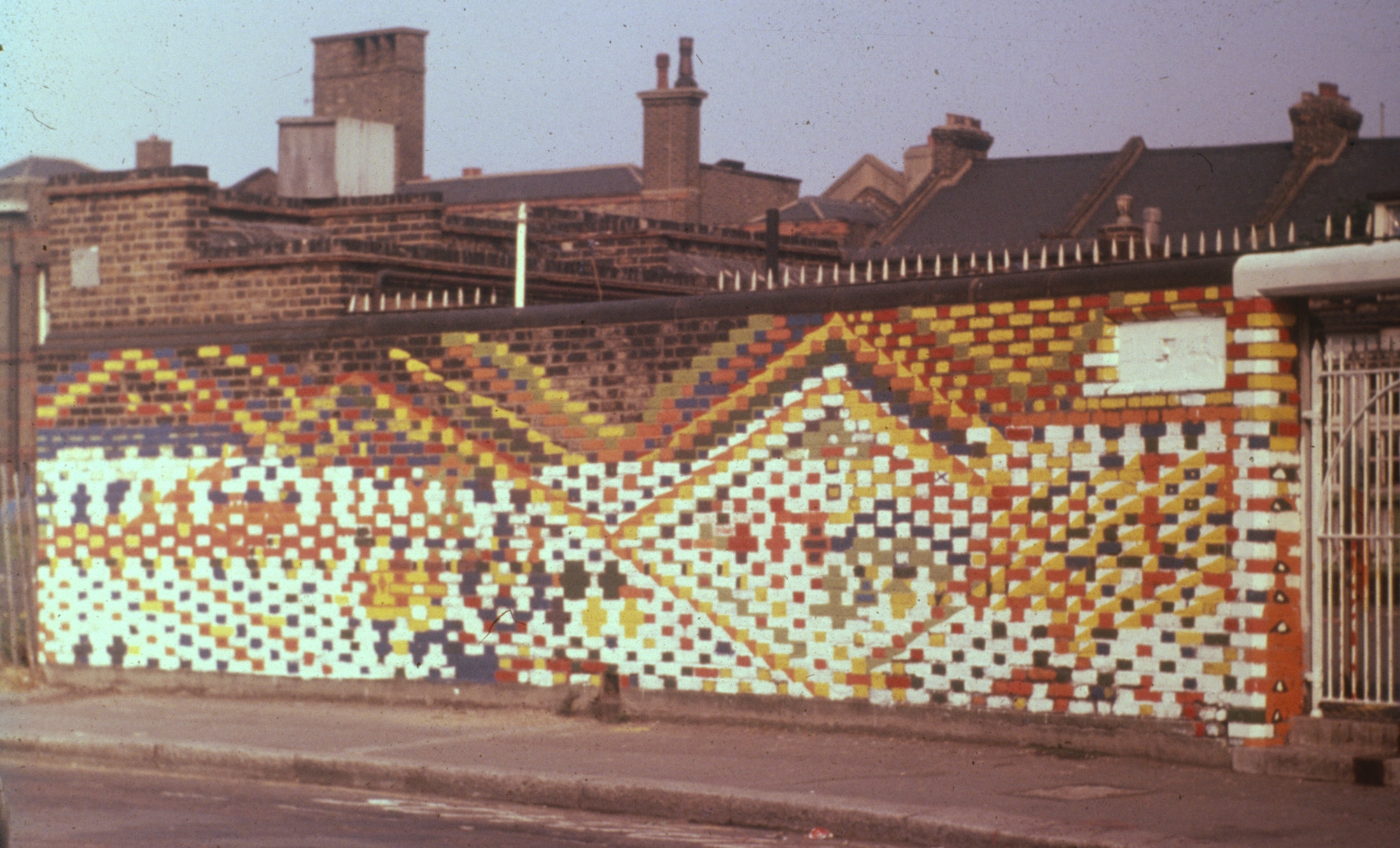
Paint on miss one.
“Based on the success of ‘Freeform Fun’ we raised our first grant funding from Newham Arts Council to do a festival in Canning Town next to an old church. Jim built a scaffolding fort from donated scaffolding; Ian Drury performed his first gig with ‘Kilburn and the Highroads’. There were lots of events and the place came alive to the many teenagers of the estate and street parties were a great success. Joan Littlewood got interested and proposed setting up a joint project, ‘Stratford Fair’, Free Form would do events to liven up the place outside, and she would put on a play inside The Theatre Royal. Their events took place with an environmental transformation of the derelict space including a participatory mural ‘paint one miss one’ with children, but the theatre retreated to what they knew best and the collaboration failed.
Free Form in Dalston
Then disaster. The majority of the group’s previous work was destroyed in a warehouse demolition, and they were homeless. But in 1973 they found accommodation in Dalston Lane in Hackney, “Two doors from ‘Centreprise’, doing ‘community involvement in books and writing’, supporting influential left-wing writers, which was inspiring. The first thing that we did was put on an exhibition of all the work -‘Towards the Live Situation’ – we had done, and being near Centreprise we got the overload of their visitors, one of whom, Chris Elphick, “ a community worker who could see a good thing” invited them to come to work in Liverpool to do the same things. “It was the summer of 1972. We took a team to do six weeks of creative workshops in Granby Street, a festival, firework shows, parades, celebrations and mad things – near the knuckle. It was tremendous, he was thrilled and asked what would we like to do next. We said, “To work with local people and create a community garden.” Two projects were completed and it started us touring.
community arts events
We went all over the place. We devised ‘The Two Week Project’ – introduce yourself, have fun and games, determine a serious project that would make a legacy and engage the community in making it. Usually it was environmental improvement but we’d start off with theatre and performance workshops that would lead sometimes to painting a mural, sometimes making a garden or a carnival. It was community arts, seen at its best, whereby you were seen as professional workers going into a community with a scenario of how to make change, with that community so engaged in it they took ownership – so it was theirs”. All the work we did in Canning Town, all the events we’d done led up to that way of working so that you could structure other people in who didn’t have visual arts training – I’m talking about theatre people, used to working with people – but they hadn’t had the same grounding as me, Barbara and Jim. We did some great pieces of work but it wasn’t about the art – it was about empowerment – that’s what it was about.
By 1974 many artist groups in the UK were working with communities were talking to each other, sharing ideas and often supporting each other’s events. Talks were started aimed at forming an Association of Community Arts (ACA), which would establish mutual support, and a base to press for funding for the artists, many of whom were receiving little or no grant aid. Recognising their need, and after continued lobbying from the ACA, the Arts Council set up a committee to service community arts groups, enabling groups to continue and expand their activities, eventually devolving responsibility, with some relief, in 1979 to regional arts associations. For ‘Free Form’, revenue funding – i.e. yearly support – enabled their touring projects to grow around the country, as well as in London. Jim Ives left Free Form in 1976/7 to run the Shoreditch Festival. He then moved on to become the Arts officer for Hackney and then worked with two different Notting Hill Carnival street bands.
grants to community arts enables work to grow
“We don’t want to be about artists. We want to make a difference with people. We are community artists, we work to the benefit of the local people, not to the benefit of the fine art establishment” was the company’s political stance. Free Form grew, mushroomed from grant aid and commissions, and did hundreds of projects around the country. In Liverpool the first community garden was created, and in Manchester after a series of events Free Form set up a community arts training project for twenty-two artists over six months, “from which we formed a creative team which carried out successful arts projects in the North West.” By 1983, there were thirty artists employed with the company, carrying out a hundred and fifty projects a year, many running simultaneously, and lead by different artists from performance or visual arts teams. New, more challenging larger projects were undertaken which incorporated smaller schemes.
two community projects in Hackney
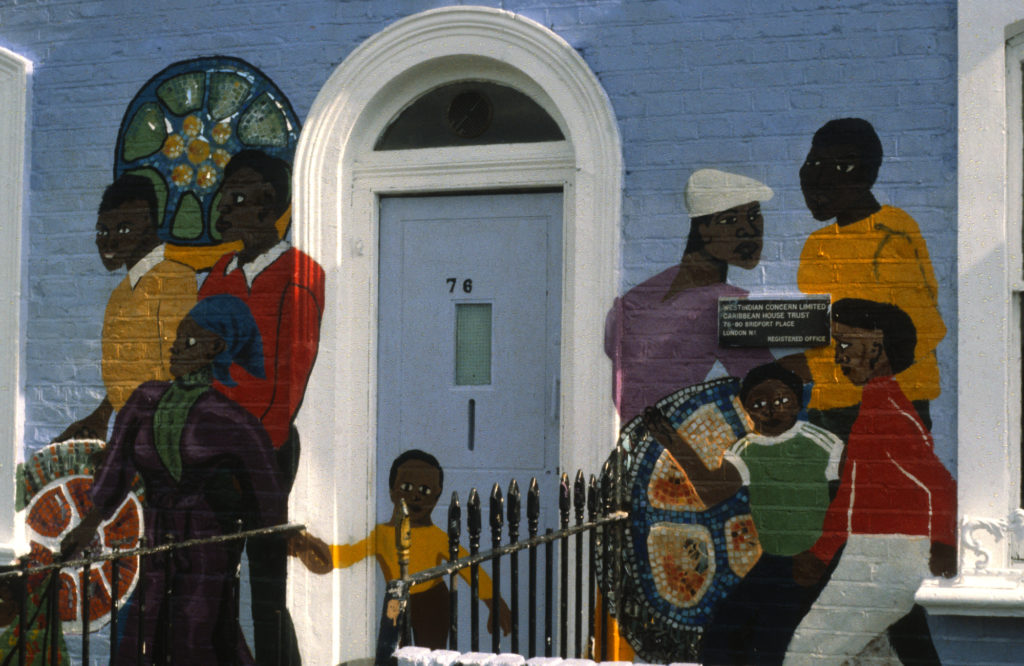
Caribbean House detail, Shoreditch Festival.
Working closer to home were other projects. For four years Free Form organised the ‘Hackney Marsh Festival’ and from that sprang the community arts centre ‘Chat’s Palace’ and buoyed by their successes in Liverpool, we set up Shoreditch Festival and painted the Caribbean House Mural. Following this the Hackney Planning department commissioned five environmental change projects involving community participation in the constructing of murals and gardens; including ‘The Island’, Evering Road, ‘Daubeney Road Garden’. ‘City Garden’, Kingsland Rd, ‘Hackney Grove Garden’ and the ‘Snake Park’, Haggerstone. These collaborations with the Planning Department were very important to the growth and credibility of our work in partnership with communities and opened up many opportunities with other local Authorities.
In 1984 the company was split in two over differences of policy. One half operated as an independent company funded by the Greater London Council (GLC), whilst Free Form continued with 50% of its grants and its commissions for projects as before, but with a renewed statement of purpose. As Martin put it, “The foundations of what we are doing is our discipline as visual artists, which is where our strength lies – the fact that we learnt to draw and paint and to communicate with people to get a response. It was time for us to move on and do something more challenging, to focus entirely on the visual arts and to do more with adults.”
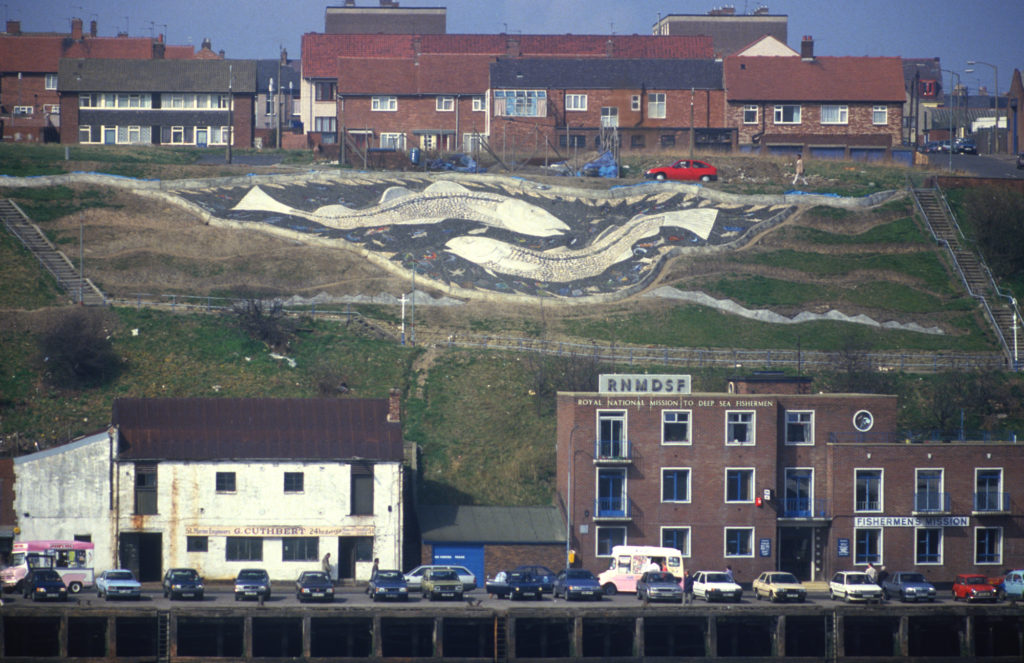
He said, “Our work thereafter concentrated on environmental improvements and took off in different directions: training, major landscaping works in towns and creating policy for urban programmes with local authorities.” One of these was for a feasibility study for North Tyneside Council, on the best way to use a Government Urban Programme to improve the local environment and engage local people. This led to creative gardens on a housing estate, and a landscape emblem ‘The Fish Scape’ for the fishing industry on the banks of the Tyne at North Shields. This then led to a festival celebrating the fishing community, which became the ‘Fish Quay Festival.’ It was great and continued year on year and is still going today. We set up a new team ‘Free Form North Tyneside’ to carry out a programme of creative work year on year.
Our creative environmental improvement work started to attract the interests of architects and commercial developers who commissioned us to improve sites and environmental change strategies for urban areas. Commissions were achieved for creative hoardings around the Jubilee site in Covent Garden. Based on the success of this we set up ‘Freeform Artworks’ lead by Alan Rossiter, to create prestigious commercial hoardings. With a team of thirty artists, they produced murals and decorative friezes in London, Manchester and Spain, which lead to further community arts work, and Public Art designs for Urban Aid programmes.
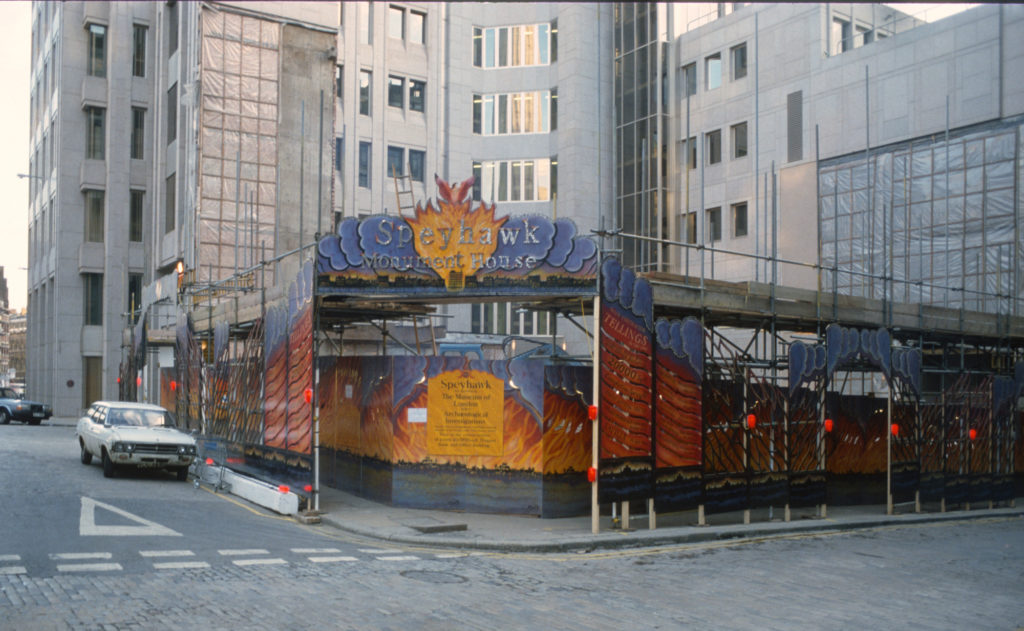
Free Form continued through to 2010, Martin and Barbara retired in 2008. During this time they had built ‘The Hothouse’ a creative hub at London Fields, Hackney, carried out programmes of Public Art and Community Art, Community Arts training, Free Form Art works and the ‘Green Bottle’ unit which developed environmental creative products from recycled glass. But the 2008 financial crash brought a down turn in commissions and grants and in 2010 the banks foreclosed on the debts taking our assets and the company closed.
